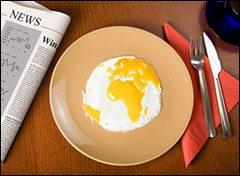
Back in the late 1990s, I happened to attend an exhibit at the Monterey Bay Aquarium in California called “Fishing for Solutions.” The experience profoundly changed my attitude toward seafood and the supposedly limitless abundance of the sea.
The exhibit focused not only on the precariousness of the fish stocks that have been reduced by overfishing, but also on the environmental degradation caused by using heavy-handed harvesting techniques and slapdash fish farming. I remember feeling stunned and shell-shocked after seeing the exhibit — and my mood sunk even deeper when I walked out of the aquarium and back into the daylight and the first thing I saw was a Bubba Gump seafood restaurant. Ouch.
Turns out I wasn’t the only one dramatically affected by the exhibit.
Sheila Bowman, Seafood Watch outreach manager at the Monterey Bay Aquarium, told me in a recent interview that “Fishing for Solutions” jolted the aquarium staff to think hard about the oceans’ limitations. Aquarium visitors, too, took the message of the exhibit to heart and started asking questions about what fish were better choices for eating, even within the aquarium’s own café.
All of these combined forces led the aquarium to create the Seafood Watch Program — producer of those influential wallet cards that tell us which fish varieties are OK to eat. The aquarium started by making a card that covered the West Coast, and now they have versions for all of the regions of the continental U.S. as well as Hawaii. The aquarium has given away 23 million hard copies to date and there have been many million more downloads from its website. The cards are updated every six months. (I make sure that I have the current version by downloading one at each equinox.)
At this point, you don’t even need a literal card in your wallet. When you’re out and about, you can also use Fishphone, a cellphone texting service provided by the Blue Oceans Institute, or the Monterey Bay Aquarium’s mobile website.
A fine kettle of fish
The Seafood Watch Program exerts considerable influence over sustainable-minded consumers and chefs. So how do they figure out which of our choices tread lightly on fish stocks — and which are leading to fishery collapse?
I asked Bowman. Turns out aquarium staff members don’t do the scientific analysis themselves; rather, they use data provided by government and other private and published sources. They then run it through a set of five criteria — separate ones for wild and farmed fish. (Some of the data for farmed fish is self-reported.)
The website lists the criteria in detail (particularly in this document [PDF], which describes the recommendation process as a whole). However, the descriptions are somewhat technical. To get a handle on exactly how Monterey evaluates the sustainability level of fish choices, I asked Bowman to explain the criteria to me in layperson’s terms. Here’s what I found out.
For wild-caught fish, Monterey uses the following criteria. Bowman emphasizes that to gain “best choices” status, a given species has to score well on all criteria.
- Biology. How vulnerable to fishing pressure is the species? Fish that reproduce quickly and in large numbers, such as anchovies, sardines, and Mahi Mahi, get a favorable ranking. Fish that reproduce slowly, later in life, and with only a few offspring at a time — think sharks, red snapper, and rockfish — score lower.
- General stock structure and abundance. This one measures how populations fare in the wild. For example, Atlantic cod stocks stand at just 1 percent of their level 200 years ago. But the Pacific cod population is healthy and part of a well-managed fishery.
- Capture techniques. In the process of harvesting a particular fish, do large numbers of untargeted fish — known as a bycatch — get caught as well? Does the fishing technique harvest only fish of a certain age? (The latter is important in the reproductive cycle.)
- Habitat damage. If harvesting a certain fish entails dragging a net across the ocean bottom, for example, it will disrupt habitats for other varieties and score low on this criterion.
- Management regime. Are there policies and laws in place to protect the fishery? Are they being followed and enforced?
For farmed fish [PDF], here’s what Monterey looks at:
- Feed. Ideally, farmed fish eat like so many Grist readers: strictly vegetarian. If the species needs to eat other fish, then the farming practice isn’t really taking pressure off the wild populations of fish that will be caught and turned into feed. Also, some fish require a lot more protein to grow than others do. For example, farmed bluefin tuna require 15 pounds of ocean fish to produce only one pound of meat.
- Effect of the farm on the species’ wild counterpart. Atlantic salmon are being farmed in the Pacific Northwest — and have escaped from these farms by the millions. The Atlantic salmon are tough and, like any invasive species, compete with the native salmon for food and space. It’s not an interactive kind of fight — they don’t go fin-à-fin — just competition for resources. Also, captive and wild populations can interbreed, resulting in a weaker hybrid that is less able to survive in the ocean.
- Diseases and parasites. Fish farms, which often produce year-round, can provide ideal habitats for parasites — which can then attack wild populations. Both farmed and wild salmon, for example, are often beset by a charming-sounding parasite called sea lice. Wild salmon have evolved forever in rough balance with sea lice, but the existence of salmon farms threatens to tip the scales (ha!) in favor of the parasite.
- Waste. Aquaculture concentrates all manner of wastes. Pesticides used to treat parasites can harm other forms of sea life. Farm operations often overuse feed; the excess decays and pulls oxygen out of the water, creating a dead zone that smothers out other sea life. Then there’s good old-fashioned poo. According to Bowman, “even industry insiders concede that a typical 200,000-fish salmon farm releases nitrogen equal to 20,000 humans, phosphorus equal to 25,000 humans, and fecal matter roughly equivalent to a city of 65,000 people.” She added, though, that farms had made good progress in minimizing this problem.
- Effective management regime. The aquarium staff looks at whether the farm management is implementing and enforcing local, national, and international laws and customs, and whether they are functioning in a way that could be described as precautionary. Benchmarks include compliance with regulations regarding the prevention and treatment of disease, as well as the use of antibiotics, biocides, and herbicides.
Sink or Swim?
After hearing in detail how the aquarium comes up with its list, I feel pretty comfortable enjoying fish types that make the group’s “best choices” list — in moderation, of course. I told Bowman how in light of the solid information that consumers can now access, I’m surprised at how many sustainable-minded consumers — many Grist readers among them — insist on completely giving up fish on environmental grounds. Why would people who would otherwise eat seafood stay away from species with “best choices” status? I can only imagine that they don’t have confidence in the lists developed and published by the Monterey Bay Aquarium and other sources.
I tried that explanation out on Bowman. “We try to keep the process as transparent as possible,” she replied. “The aquarium doesn’t take any funding from anyone in the fishing industry. Our mission and goal is the stewardship of the oceans and I would hope people would take that into consideration when they are looking for information they can trust.”
It’s easy enough to make broad statements like “there aren’t any fish that can be harvested sustainably.” But the truth is that the health of the world’s fisheries is species- and situation-specific. We’re fortunate that the Monterey Bay Aquarium has the resources and expertise to interpret the complex data available on fisheries. The question of precisely how reliable that data is, however, will have to await another column.
Dungeness Crab-Stuffed Squid with Charmoula
Serves 4 people (3 squid per person)
Courtesy of Dory Ford, executive chef at the Portola Restaurant and Bon Appétit Management Company at the Monterey Bay Aquarium.

Roz’s crab-stuffed squid creation.
Photo: Craig and Deanna Dement Myers
When I tested this recipe here in Boston, I used Jonah crabmeat, as there wasn’t any Dungeness available. I was shocked to find fresh corn from Florida in the store (maybe it’s always there and I just don’t see it because I don’t normally buy fresh corn in March) and I bought it even though it’s out of season so that I could test the recipe properly. I also bought some imported tomatoes so that I could make the photo look appealing. I used a grill pan to cook the stuffed squid as it is still very chilly here and my BBQ grill isn’t ready for the season yet.
1 pound Dungeness crab meat
1 teaspoon fresh Italian parsley or dill, minced
1/2 teaspoon sea salt
1/4 teaspoon fresh cracked black pepper
1 cob sweet white corn (use only the kernels)
2 tablespoons lemon juice
1 shallot, minced
12 squid tubes
1 tablespoon canola oil
1/2 teaspoon ground cumin
1/2 teaspoon ground coriander
1/8 teaspoon cayenne pepper
1/2 teaspoon sea salt
1 teaspoon paprika
1 teaspoon cilantro, finely chopped
1 teaspoon garlic, finely chopped
2 tablespoons finely minced onion or shallot
2 tablespoons lemon juice
4 tablespoons extra virgin olive oil
- Combine all the filling ingredients in a bowl. Stir to just combine.
- Stuff squid tubes with crab filling. Set aside.
- Whisk sauce ingredients together in small bowl and reserve.
- Season stuffed squid tubes lightly with salt and pepper and lightly coat them with canola oil.
- Grill on preheated barbecue or charbroiler approximately 3-4 minutes, turning occasionally.
- Remove to plate. Drizzle with charmoula sauce. Serve immediately.


